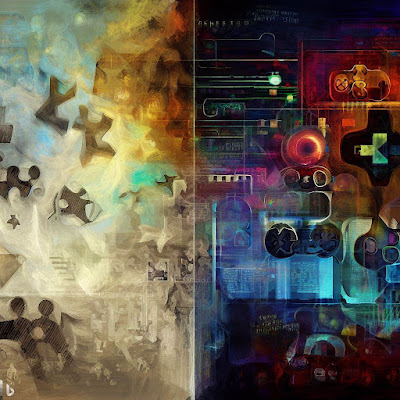Search This Blog
Talk related Game design, Development, Importance of every element in game.
Featured
- Get link
- X
- Other Apps
Evolution of Gaming: A Comparative Analysis of Game Types and the Impact of UI/UX Design
Evolution of Gaming: A Comparative Analysis of Game Types and the Impact of UI/UX Design
Introduction
Over the years, the gaming industry has witnessed a tremendous metamorphosis, with digital games spanning from vintage arcade games to contemporary masterpieces. User Interface (UI) and User Experience (UX) designers' roles have evolved along with gaming technology and design. In this blog, we'll look at the historical evolution of gaming genres and the crucial role that UI/UX design has had in their creation.
Classic Arcade Games:
Pac-Man, Space Invaders, and Donkey Kong were just a few of the arcade classics that captured players' attention in the 1970s and 1980s, heralding the beginning of the gaming business. These games emphasize rapid reactions and high scores in their design for short, pick-up-and-play experiences. Although their user interface (UI) was basic by today's standards, they demonstrated the potential of compelling gameplay and helped players discover the joy of gaming.
UI/UX that works well For instance, "Pac-Man" (Namco):
Players enjoyed and became addicted to the game's basic, classic UI because to its maze design and simple controls.
Poor UI/UX "E.T. the Extra-Terrestrial" (Atari):
Due to its difficult-to-use interface, this game quickly gained a reputation as one of the worst ever created.
Retro Console Games:
Retro console games first appeared on systems like the Nintendo Entertainment System (NES), Sega Genesis, and others in the 1980s and 1990s. These games pushed the limits of gaming technology at the time by combining 2D platformers, side-scrolling shooters, and adventure games.
UI/UX that works well "Super Mario World" (Nintendo):
Super Mario World provided a captivating and engrossing experience with its recognizable HUD, user-friendly interface, and fluid-level transitions.
A poor UI/UX illustration is "Bubsy 3D" (Accolade):
This game's rugged camera controls and clumsy user interface were criticized for their poor design and hampered player enjoyment.
Early PC Games:
In the 1990s, the first PC games appeared, introducing gamers to new game genres like point-and-click adventures and first-person shooters. The promise of PC gaming was demonstrated by titles like Doom and Myst, which had an impact on UI/UX design and future game design.
UI/UX that works well For instance, "Myst" (Cyan, Inc.):
Players enjoyed a thrilling and immersive puzzle-solving experience with Myst's wonderfully designed UI and simple point-and-click controls.
A poor UI/UX example is the game "Daikatana" (Ion Storm):
Whose complex HUD and perplexing UI features led to the game's unfavorable reviews and commercial failure.
Early Online Multiplayer Games:
A pioneering online gaming experience was created by early multiplayer online games like Ultima Online and EverQuest that brought players together in virtual worlds.
The Sony Online Entertainment game "EverQuest" is a good example of UI/UX:
An easy multiplayer experience was made possible by the game's logical chat system, user-friendly menu layout, and straightforward map navigation.
Bad UI/UX A good illustration is "Asheron's Call 2" (Turbine Entertainment):
The very convoluted skill system and UI of this game contributed to its eventual discontinuation.
The Impact of UI/UX Design on Gaming:
Gaming has undergone a radical change as a result of UI/UX design. As technology advanced, games became more immersive, accessible, and visually appealing. UI/UX designers have done the following to help games succeed:
Deeper player immersion has been made possible by engaging UI/UX design, which has muddled the boundaries between the actual world and the virtual one.
Enhancing Accessibility: Thoughtful UI/UX design has opened up gaming to a wider audience and accommodated players of all skill levels.
Increasing Player Engagement and Retention: Engaged players have higher retention rates and longer play sessions as a result of responsive UI/UX features.
Carefully thought-out in-game shops and microtransactions boost user spending, assisting in the game's monetization.
Conclusion:
Since the era of vintage arcade games and vintage consoles, the gaming industry has advanced significantly. The rich history and cultural relevance of gaming have been influenced by every genre and game type. We can anticipate even more captivating and immersive gaming experiences in the future as technology and UI/UX design continue to advance.
Reference:
1. Drachen, A., Sifa, R., Bauckhage, C., & Thurau, C. (2012). Guns, swords and data: Clustering of player behavior in computer games in the wild. In Proceedings of the international conference on entertainment computing (pp. 286-294).
2. Hamilton, W. (2019). User interface design for video games: The interplay of text, images, and gameplay. Routledge.
- Get link
- X
- Other Apps
Popular Posts
The Crucial Role Played by UI/UX Designers in the Gaming Industry
- Get link
- X
- Other Apps
Mass Effect: Andromeda - Unraveling the Missteps and UI/UX Misadventures
- Get link
- X
- Other Apps
Navigating Game Development Challenges: A Comparative Analysis of UI/UX for Different Platforms
- Get link
- X
- Other Apps
Shaping Tomorrow's Gaming Landscape: The Future of Game Development, Design, and the Evolving Role of UI/UX
- Get link
- X
- Other Apps

.jpeg)


.jpeg)

.png)





.jpg)






Comments
Post a Comment